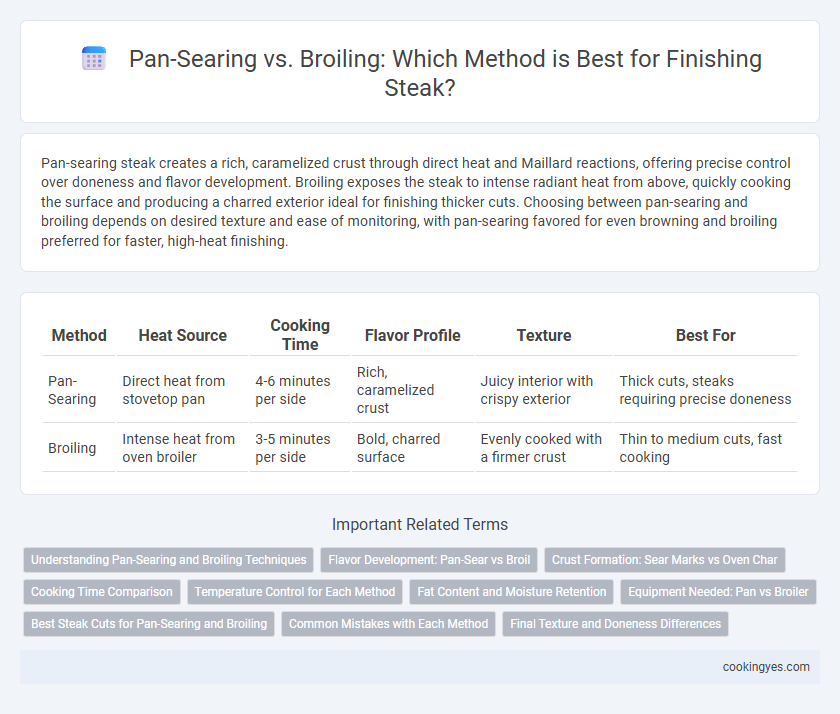Pan-searing steak creates a rich, caramelized crust through direct heat and Maillard reactions, offering precise control over doneness and flavor development. Broiling exposes the steak to intense radiant heat from above, quickly cooking the surface and producing a charred exterior ideal for finishing thicker cuts. Choosing between pan-searing and broiling depends on desired texture and ease of monitoring, with pan-searing favored for even browning and broiling preferred for faster, high-heat finishing.
Table of Comparison
| Method | Heat Source | Cooking Time | Flavor Profile | Texture | Best For |
|---|---|---|---|---|---|
| Pan-Searing | Direct heat from stovetop pan | 4-6 minutes per side | Rich, caramelized crust | Juicy interior with crispy exterior | Thick cuts, steaks requiring precise doneness |
| Broiling | Intense heat from oven broiler | 3-5 minutes per side | Bold, charred surface | Evenly cooked with a firmer crust | Thin to medium cuts, fast cooking |
Understanding Pan-Searing and Broiling Techniques
Pan-searing steak creates a rich, caramelized crust by cooking at high heat in a preheated skillet, which locks in juices and enhances flavor complexity through the Maillard reaction. Broiling exposes the steak to intense, direct heat from above in the oven, producing a seared exterior while maintaining a juicy center, ideal for thicker cuts. Mastery of both techniques allows precise control over crust development and internal doneness, optimizing the steak's texture and taste.
Flavor Development: Pan-Sear vs Broil
Pan-searing a steak enhances flavor through the Maillard reaction, creating a rich, caramelized crust due to direct contact with high heat and rendered fat. Broiling exposes the steak to intense radiant heat from above, resulting in a slightly charred exterior with a smoky flavor but less crust formation. Pan-searing offers deeper flavor complexity and texture, while broiling provides a quicker finish with pronounced surface charring.
Crust Formation: Sear Marks vs Oven Char
Pan-searing creates a rich, golden-brown crust through direct contact with a hot skillet, producing distinct sear marks that enhance texture and flavor via the Maillard reaction. Broiling, on the other hand, uses intense radiant heat from above to char the steak's surface, yielding a more uniform, caramelized crust without defined grill-like sear marks. The choice between pan-searing and broiling directly impacts the steak's crust formation, influencing both aesthetic appeal and the complexity of taste.
Cooking Time Comparison
Pan-searing steak typically takes about 3-5 minutes per side, offering a quick and controllable cooking process that achieves a caramelized crust. Broiling requires a slightly longer time, usually 5-7 minutes per side, using intense direct heat from above to cook the steak evenly. Both methods can produce a flavorful finish, but pan-searing provides faster heat application, ideal for thinner cuts.
Temperature Control for Each Method
Pan-searing steak allows precise temperature control by adjusting stovetop heat levels, enabling consistent browning and a controlled crust formation. Broiling exposes steak to intense, direct heat from above, requiring careful distance management to prevent overcooking or burning while achieving a charred exterior. Maintaining optimal internal temperature varies: pan-searing benefits from gradual heat, whereas broiling demands rapid, high-temperature exposure for the desired finish.
Fat Content and Moisture Retention
Pan-searing steak creates a Maillard crust that helps lock in moisture and render fat evenly, preserving juiciness and enhancing flavor. Broiling exposes steak to high, direct heat from above, which can lead to quicker fat melting and potential moisture loss. For higher-fat cuts, pan-searing offers better control over fat retention and moisture compared to broiling's intense heat that may dry out the steak.
Equipment Needed: Pan vs Broiler
Pan-searing a steak requires a heavy-bottomed skillet, preferably cast iron, to ensure even heat distribution and a well-developed crust, while broiling demands an oven with a broiler setting and a broiler pan or rack to position the steak close to the heating element. Cast iron skillets excel at maintaining high temperatures essential for Maillard reaction, whereas broilers deliver intense, direct heat from above that quickly caramelizes the steak's surface. Choosing between pan-searing and broiling depends on the available equipment and the desired control over the steak's finish.
Best Steak Cuts for Pan-Searing and Broiling
Ribeye, striploin, and filet mignon stand out as the best steak cuts for pan-searing due to their marbling and thickness, which promote a perfect crust and juicy interior. For broiling, top sirloin and flank steak are ideal because they respond well to the intense, direct heat, developing rich flavor without overcooking. Choosing the right cut enhances texture and taste whether finishing your steak with pan-searing or broiling techniques.
Common Mistakes with Each Method
Pan-searing steak often results in common mistakes such as overcrowding the pan, which leads to steaming instead of searing, and using insufficient oil, causing uneven browning. Broiling mistakes include placing the steak too far from the heat source, resulting in undercooked interiors, and neglecting to preheat the broiler, which can prevent the formation of a proper crust. Both methods require precise temperature control to avoid overcooking or drying out the steak.
Final Texture and Doneness Differences
Pan-searing steak delivers a caramelized crust with a tender, juicy interior due to direct contact with hot oil, preserving moisture and enhancing Maillard reaction flavors. Broiling uses intense radiant heat from above, creating a slightly less crispy exterior but evenly cooked doneness, often resulting in a firmer texture. The choice impacts final texture where pan-searing yields a softer bite while broiling produces a more uniform cook and slightly chewier finish.
Pan-searing vs Broiling for Steak Finish Infographic

 cookingyes.com
cookingyes.com